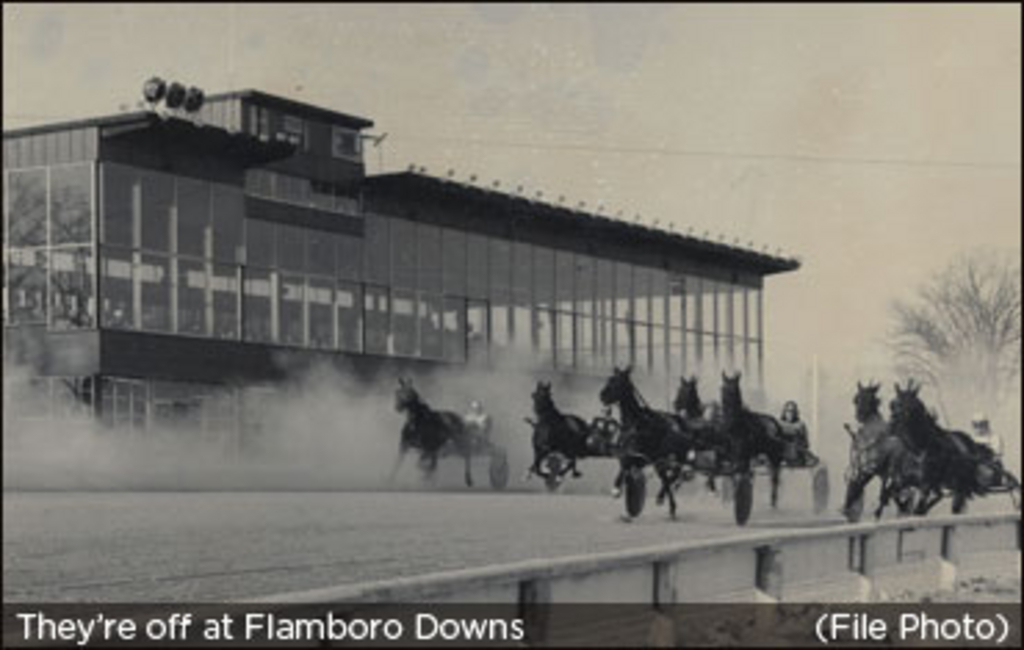
In this week's Rewind, Robert Smith recalls the start up of Flamboro Downs and takes us back to the early years in the first of a three-part series
.
Whether you choose to call it a birthday, an anniversary or just a plain old milestone, Flamboro is about to turn 35. When racing began on the evening of April 9, 1975 an exciting new chapter of harness racing history was officially underway. As we reflect on those 35 years of history and memories, there is a lot to remember.
As with all ventures in life, be they large or small, each has a beginning and they often begin as a "dream" or a simple idea. In the case of the creation of Flamboro Downs the main architect and "dreamer" was a gentleman named Thomas "Ray" Connell. While he collaborated with many and partnered with several people, the new track was his "baby". Mr. Connell had a lengthy and interesting career, starting out as a dairy farmer he eventually became a nationally known politician rising to a position near the top of the Provincial legislature serving as Minister of Public Works from 1958 to 1968. His ownership and management of Flamboro Downs was undoubtedly his most rewarding business accomplishment as it combined his love of horses and harness racing along with a highly successful raceway operation. His personal imprint was placed on the sport as his homebred horses, many bearing the name Conray, were very successfully campaigned by the father son team of Don and Kent Davies.
Mr. Connell considered numerous sites for his new track, all located close to his home base of Dundas, Ont. He even looked at the possibility of locating at the Ancaster Fairgrounds. His ultimate choice however was a large parcel of land located on Highway 5 comprised of 161 acres. It was estimated to be within range of at least one million potential fans. He was a visionary of sorts and was not one to back down easily when in pursuit of his dreams.
It seemed the track would become a reality in 1971 when Connell teamed up with Charles Juravinski to purchase the land. Mr. Juravinski had no previous Raceway management experience but was well known in the construction business, at the time the Secretary Treasurer of Wilchar Construction Co., a local firm. He would eventually serve as V.P. and General Manager, the most dominant role at the new track. They were soon to find out that not everyone shared their vision nor their enthusiasm. Many obstacles and roadblocks followed leading to debates, public meetings, objections and appeals. As time passed cost estimates also rose sharply. Another hugely popular person in the racing world, Mr. John Grant of Hornby fame joined the team to help with his expertise and financial backing. Finally after years of debate, discussion and planning, all obstacles were removed. In May of 1974 the first shovel entered the ground as construction began and in less than one year the operation became a reality. This in itself was a monumental accomplishment.
One of the main aims of Mr. Connell was to provide an extremely fast and safe racing surface for his future backstretch patrons. In a somewhat controversial move, he chose to go with a traditional half-mile track which was a reversal of form as five-eighths mile and larger tracks had become the size of choice. As a starting point he hired a man named Paul Kurtz of Ariss, Ont., an individual who possessed a rare combination of talents. At the age of 33, he was a Professional Engineer and also an accomplished horseman perhaps best known as the driver of Otisarno. He was chosen to serve as Director of Racing as well as overseeing the building of the track.
The track would have an entirely new design based on a different ratio of banking on the turns and featured an all-weather stone dust base. Traditionally tracks had a 1:12 Ratio of slope while the Flamboro design would be 1:5. The aim in simplified terms was to reduce the need to slow down in the turns as well as minimizing the stress on horse's legs and muscles. A prototype of the final design already existed at Mr. Kurtz's farm track. The new track was 80 feet wide, making it wider than any other Ontario track.
The stables were to be ultra-modern and unique in design with aisles running the width rather than length of the barn to minimize congestion. Well-drained wash racks with heat lamps were another feature. Trainers and grooms would enjoy quarters separate from the stabling area and a spacious recreational area as well as a cafeteria would be included. In addition, a separate half-mile training track would be constructed for day time training; it too would have the "banked" turns.
The price tag for the new "Dream Track" was pegged at $4 to 5 million. With a minimum purse of $800, there would be no problem attracting lots of horses.
When Mr. Connell passed away November 14, 1986 at the age of 70, he left a huge void not only for his family but also for the racing community. He had lived to see his plans and dreams become a huge success and an asset to the sport. He served as Flamboro's President from its opening until he retired in 1982, remaining as Honorary Chairman of the Board. Under his stewardship Flamboro rose to a position of prominence, well known and respected across the Continent. Those who eulogized him placed his human attributes well beyond his life's accomplishments. He was recalled as a man who combined sincerity, humility, caring and honesty throughout his lifetime. Nice words to be remembered by.
Next week I will recall the actual opening of the then brand new Flamboro Downs. The Raceway's newly adopted slogan was "The Track of the Future......Now."

